Study on the Bending and Joint Performances of Reinforced Concrete Beams Using High-Strength Rebars
Abstract
:1. Introduction
2. Materials and Methods
2.1. Experimental Design
2.1.1. Joint Performance Test
- : Thickness of the reinforcing bar (mm)
- : Lap splice rebar (MPa)
- : Concrete grade (MPa)
- : Lateral rebar index
2.1.2. Direct Tensile Test
2.2. Materials Used
2.2.1. Direct Tension Test
2.2.2. High-Strength Threaded Reinforcement
2.3. Experimental Specimen Production
2.4. Experimental Method
2.4.1. Direct Tensile Test
2.4.2. Joint Performance Test
3. Experimental Results and Analyses
3.1. Direct Tensile Test
3.2. Joint Performance Test
4. Discussion and Conclusions
- (1)
- The experimental results of 600D32 and 670D30, which are overlapping joint experiments with joint lengths calculated by the current structural design standard formula, are both above the nominal strength, which is expected to apply the current regulations. In addition, the overlap joint experiments exceed the nominal load given by the current design basis, even though they do not have a lateral reinforcement. In Seliem et al. [8], the number of experiments with lateral reinforcement increases by 1.28 times compared to those without lateral reinforcement.
- (2)
- Second, the results of the joint performance tests showed that the joint length test results of the 600D32 and 670D30 test specimens calculated with Equation (1) listed in the KCI Concrete Structural Design Standard were all above the nominal strength.
- (3)
- The maximum loads of the coupler joint specimens were 21.5% and 47.9% higher in the cases of the 600D32C and 670D30C specimens compared with the overlap joint specimens, respectively. They were destroyed after the ductile section after the yield load. Therefore, it is judged that the coupler joint is more effective than the overlap joint. The overlapping joint test specimen could not confirm the yield of the reinforcing bar, which is believed to be attributed to the fact that the transverse constraining reinforcement was not placed. To use the threaded reinforcement for the overlapping joint, an additional experiment with transverse constraining reinforcing bars is necessary.
- (4)
- When comparing the maximum load for the coupler and lock nut joint test specimen, the 600D32CL specimen increased the load by 5.4% compared with the 600D32C specimen, and the 670D30CL specimen reduced the load by 1.8% compared with the 670D30C specimen. Therefore, it is inferred that the joints between the coupler and the lock nut and the coupler joint subjected to bending stresses have similar performances.
Author Contributions
Funding
Institutional Review Board Statement
Informed Consent Statement
Data Availability Statement
Conflicts of Interest
References
- Rizkalla, S.; El-Hacha, R.; Elagroudy, H. Bond Characteristics of High-Strength Steel Reinforcement. ACI Struct. J. 2006, 103, 1–46. [Google Scholar] [CrossRef]
- Seliem, H.M.; Hosny, A.; Rizkalla, S.; Zia, P.; Briggs, M.; Miller, S.; Darwin, D.; Browning, J.; Glass, G.M.; Hoyt, K.; et al. Bond Characteristics of ASTM A1035 Steel Reinforcing Bars. ACI Struct. J. 2009, 106, 530–539. [Google Scholar]
- Hamad, B.S.; Jirsa, J.O.; Natalie, I.; De Paulo, D. Anchorage Strength of Epoxy-Coated Hooked Bars. ACI Struct. J. 1993, 90, 210–217. [Google Scholar]
- Choi, W.S. Applicability of Current Design Code for Development and Splice of SD600 Re-Bars. Master’s Thesis, Seoul National University, Seoul, Korea, 2011. [Google Scholar]
- Han, K.B. A Study on the Characteristics of Mechanical Spice of Deformed Reinforcing Bar. Master’s Thesis, Gunkuk University, Seoul, Korea, 2000. [Google Scholar]
- Han, B.S. A Study of Tensile Strength on the Mechanical Joint of Reinforcing Bar. Master’s Thesis, Kangwon National University, Chuncheon, Korea, 2002. [Google Scholar]
- ACI Committee 439. Mechanical Connections of Reinforcing Bars (ACI439.3R-91); American Concrete Institute: Farmington Hills, MI, USA, 1999; pp. 1–16. [Google Scholar]
- Choi, W.S.; Park, H.G.; Chung, L.; Kim, J.K. Experimental Study for Class B Lap Splice of 600 MPa (87 ksi) Reinforcing Bars. ACI Struct. J. 2014, 111, 49–58. [Google Scholar]
- Apostolopoulos, C.A.; Michalopoulos, D.; Dimitrov, L. Numerical simulation of tensile mechanical behavior of lap welded reinforcing steel bar joints. Bulgarian. J. Eng. Des. 2009, 3, 5–11. [Google Scholar]
- Goksu, C.; Yilmaz, H.; Chowdhury, S.; Orakcal, K.; Ilki, A. The Effect of Lap Splice Length on the Cyclic Lateral Load Behavior of RC Members with Low-Strength Concrete and Plain Bars. Adv. Struct. Eng. 2014, 17, 639–658. [Google Scholar] [CrossRef]
- Ghatte, H.F. Failure mechanisms and cracking performance of T-shaped SCC beam-column connections at top floor: Test results and FE modeling. Structures 2020, 28, 1009–1018. [Google Scholar] [CrossRef]
- Goksu, C.; Inci, P.; Ilki, A. Effect of Corrosion on Bond Mechanism between Extremely Low-Strength Concrete and Plain Reinforcing Bars. J. Perform. Constr. Facil. 2016, 30, 04015055. [Google Scholar] [CrossRef]
- Ghatte, H.F. External steel ties and CFRP jacketing effects on seismic performance and failure mechanisms of substandard rectangular RC columns. Compos. Struct. 2020, 248, 112542. [Google Scholar] [CrossRef]
- Sun, Y.; Liu, Y.; Wu, T.; Liu, X.; Lu, H. Numerical Analysis on Flexural Behavior of Steel Fiber-Reinforced LWAC Beams Reinforced with GFRP Bars. Appl. Sci. 2019, 9, 5128. [Google Scholar] [CrossRef] [Green Version]
- Karayannis, C.G.; Kosmidou, P.-M.K.; Chalioris, C.E. Reinforced Concrete Beams with Carbon-Fiber-Reinforced Polymer Bars—Experimental Study. Fibers 2018, 6, 99. [Google Scholar] [CrossRef] [Green Version]
- Nardone, F.; Lignola, G.P.; Prota, A.; Manfredi, G.; Nanni, A. Modeling of flexural behavior of RC beams strengthened with mechanically fastened FRP strips. Compos. Struct. 2011, 93, 1973–1985. [Google Scholar] [CrossRef]
- Lignola, G.; Prota, A.; Manfredi, G.; Cosenza, E. Non-linear modeling of RC rectangular hollow piers confined with CFRP. Compos. Struct. 2009, 88, 56–64. [Google Scholar] [CrossRef]
- Standard National Institute (BSN). Procedure of Earthquake Resistant for Building Structure and Non-Building (SNI 1726-2012); BSN Publisher: Jakarta, Indonesia, 2012. [Google Scholar]
- Standard National Institute (BSN). Structural Concrete Requirement for Building (SNI 2847-2013); BSN Publisher: Bandung, Indonesia, 2013. [Google Scholar]
- Wight, J.K.; Rabbat, B.G. Building Code Requirements for Structural Concrete and Commentary (ACI 318M-05); American Concrete Institute (ACI) Publisher: Farmington Hills, MI, USA, 2005. [Google Scholar]
- Bsisu, K.A.; Hunaiti, Y.; Younes, R. Flexural ductility behavior of strengthened reinforced concrete beams using steel and CFRP plate. Jordan J. Civ. Eng. 2012, 6, 304–312. [Google Scholar]
- Ho, J.M.C.; Kwan, A.K.H. Fluxural Ductility Assessment and Concurrent Flexural Strength and Ductility Design of Rein-forced Concrete Beams. In Proceedings of the 14th World Conference on Earthquake Engineering, Beijing, China, 12–17 October 2008. [Google Scholar]
- Kwan, A.K.H.; Ho, J.M.C.; Pam, H.J. Flexural strength and ductility of reinforced concrete beams. Proc. Inst. Civ. Eng. Struct. Build. 2002, 152, 361–369. [Google Scholar] [CrossRef]
- Mahlisani, N.; Teguh, M. Flexural Performance of RC Beams with Variety Joints of Reinforcing Steel Rebars. In Proceedings of the 4th ICSBE and the 3rd ISTEcS Proceeding, FTSP, UII, Yogyakarta, Indonesia, 21–22 October 2014. [Google Scholar]
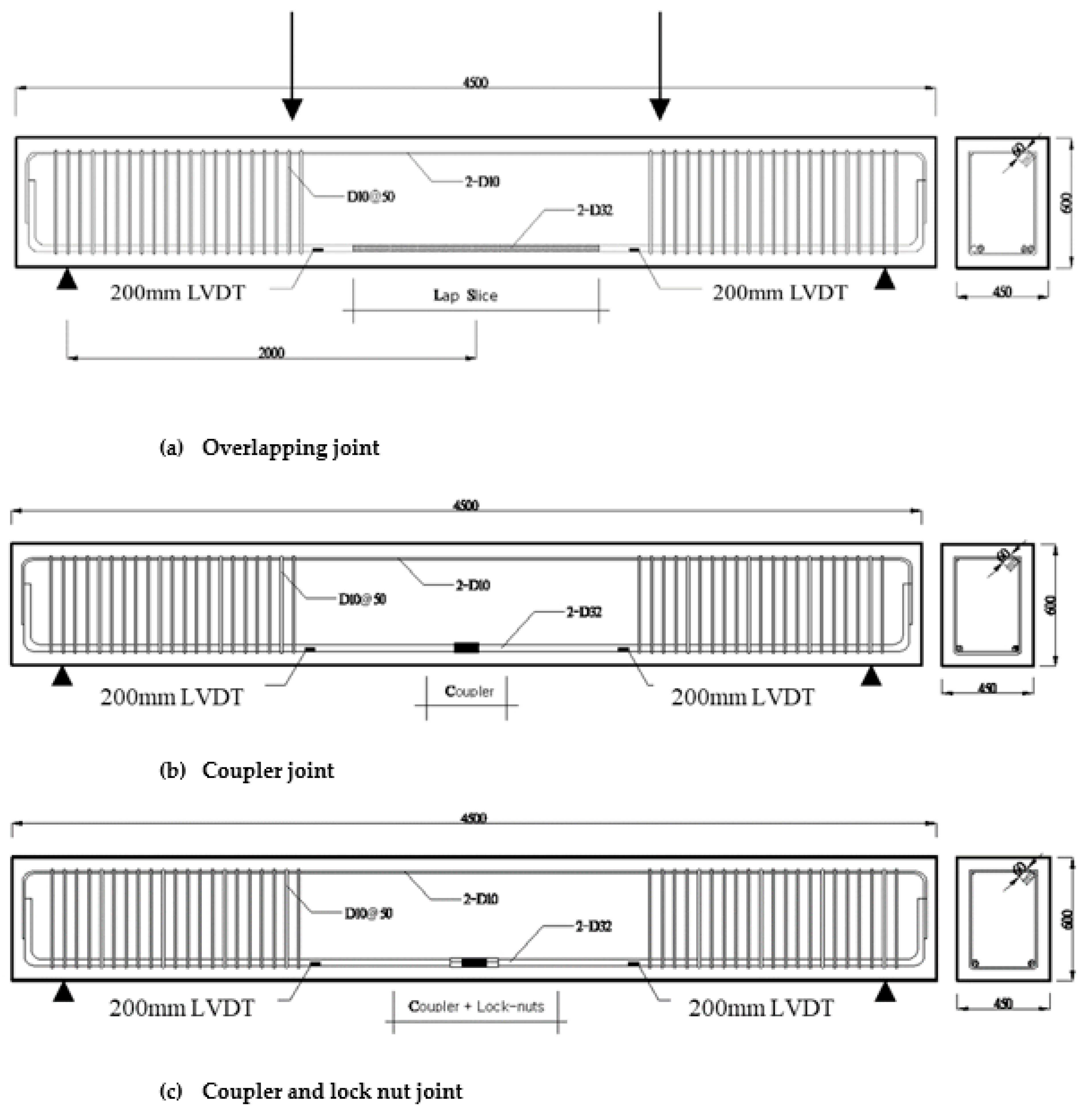


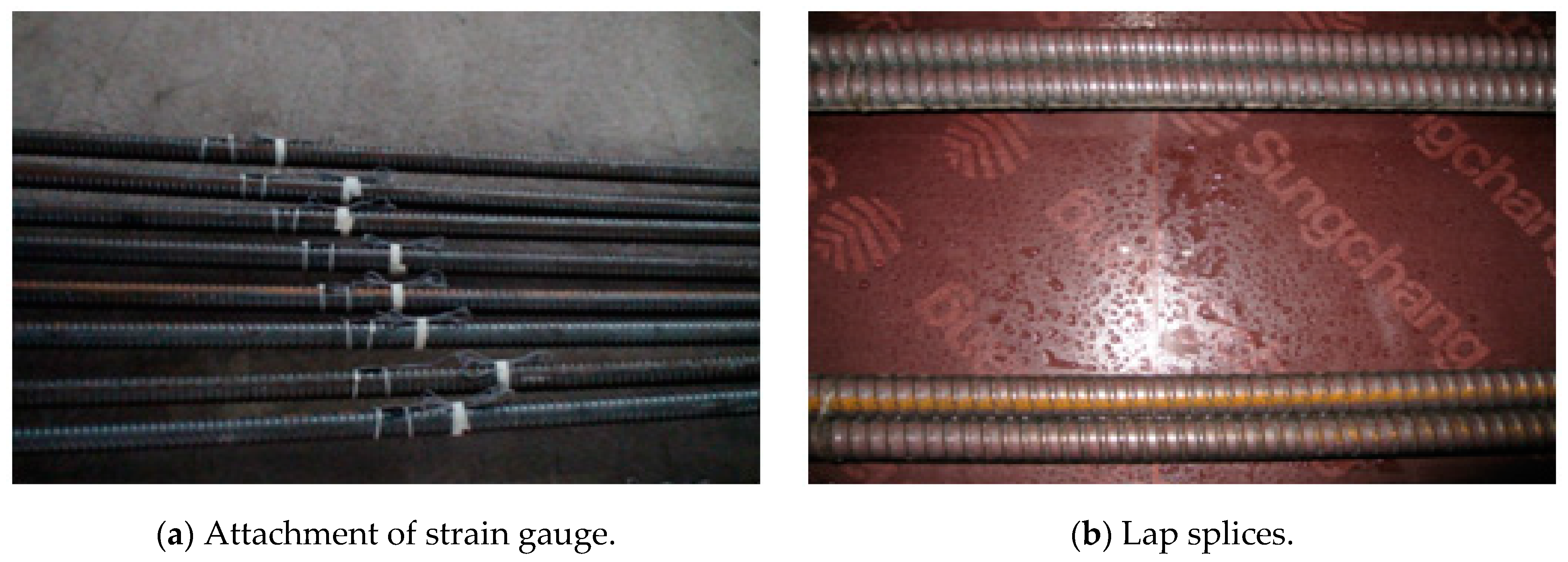
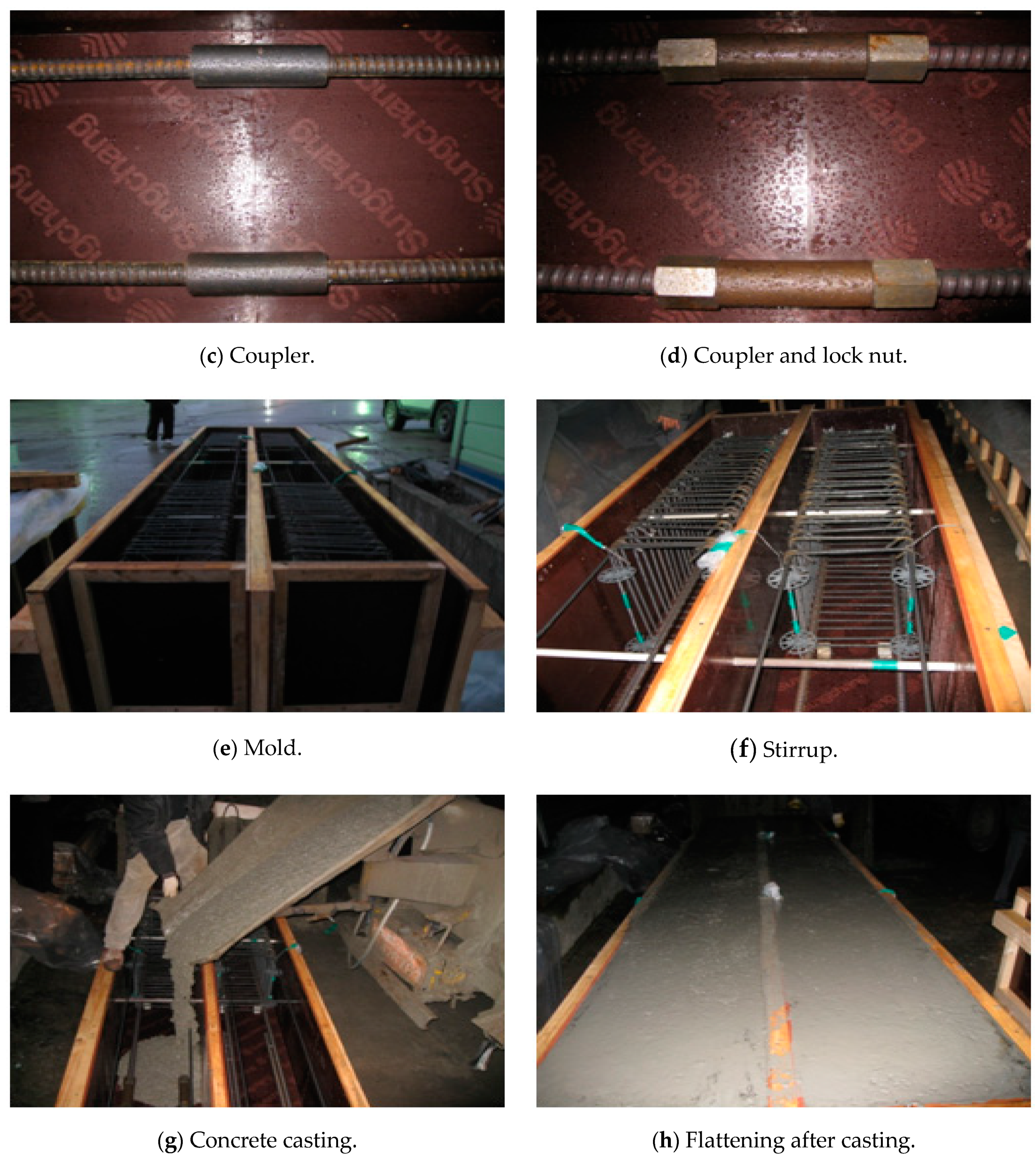

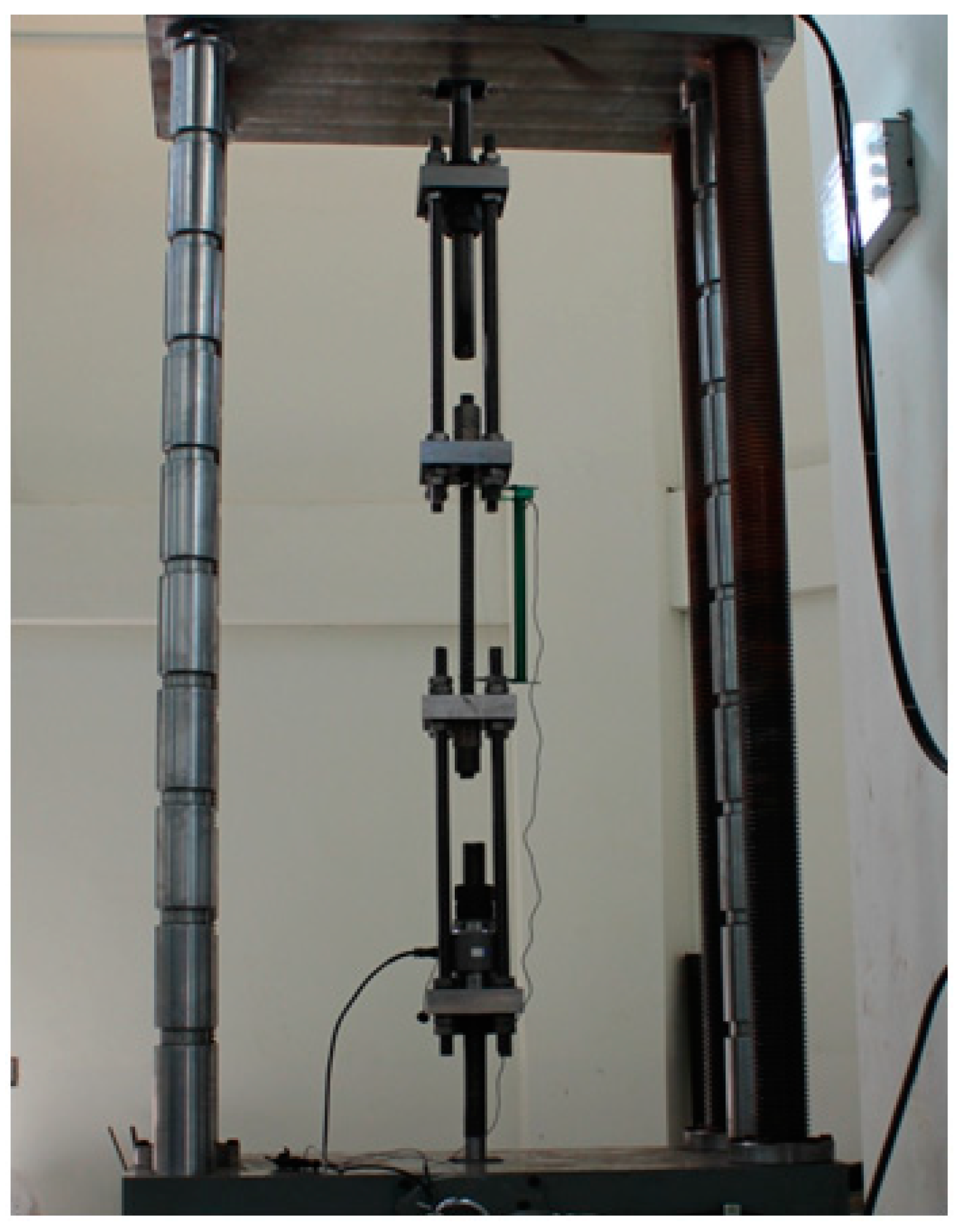
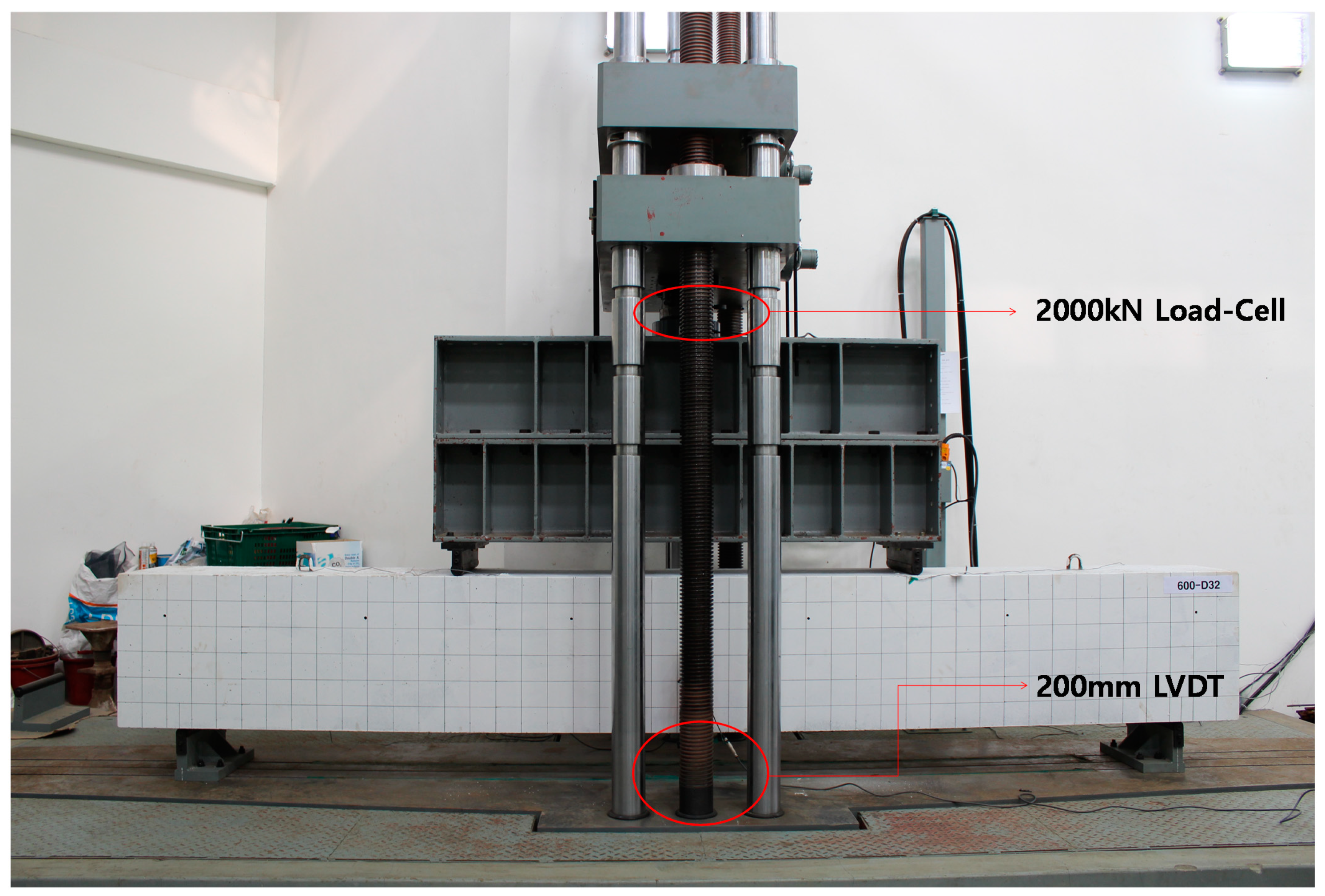

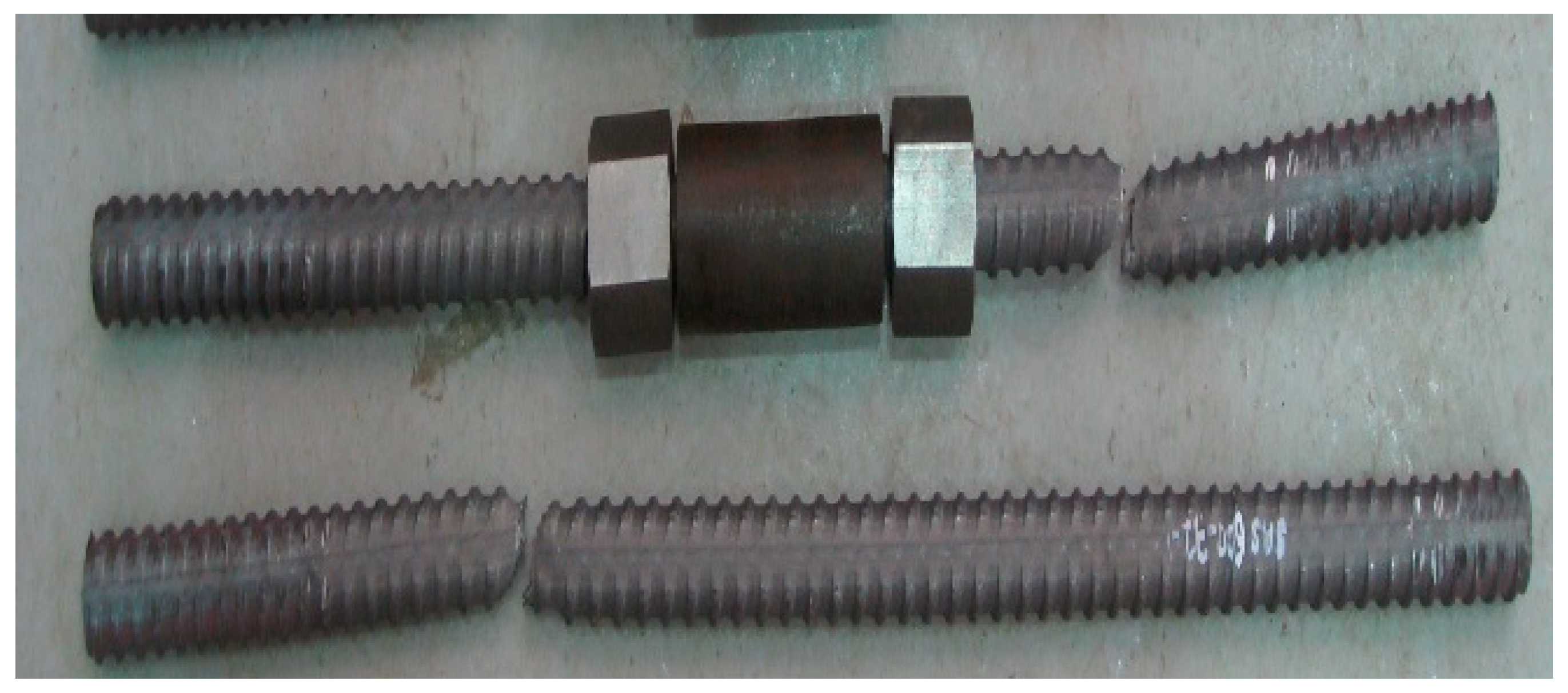


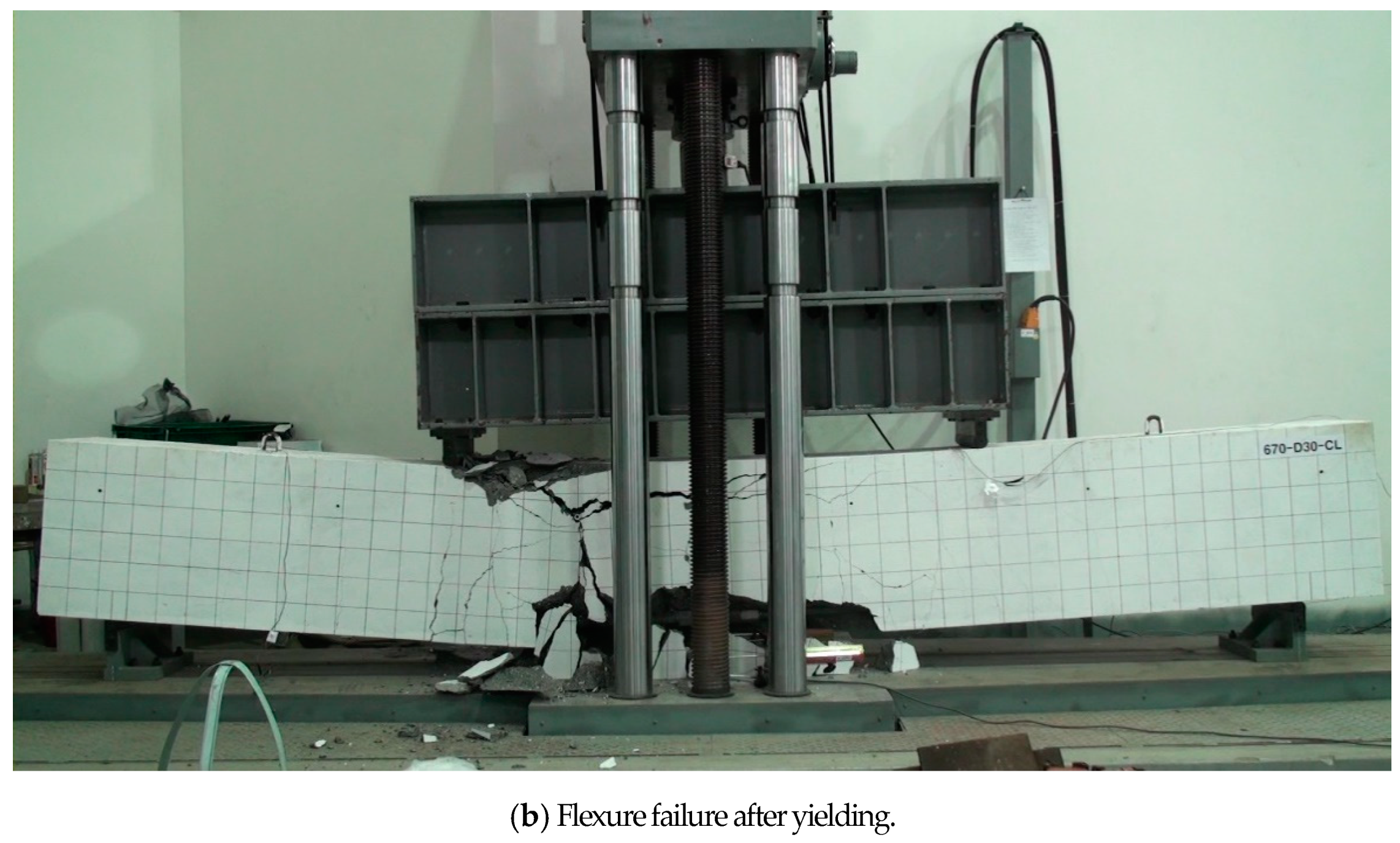

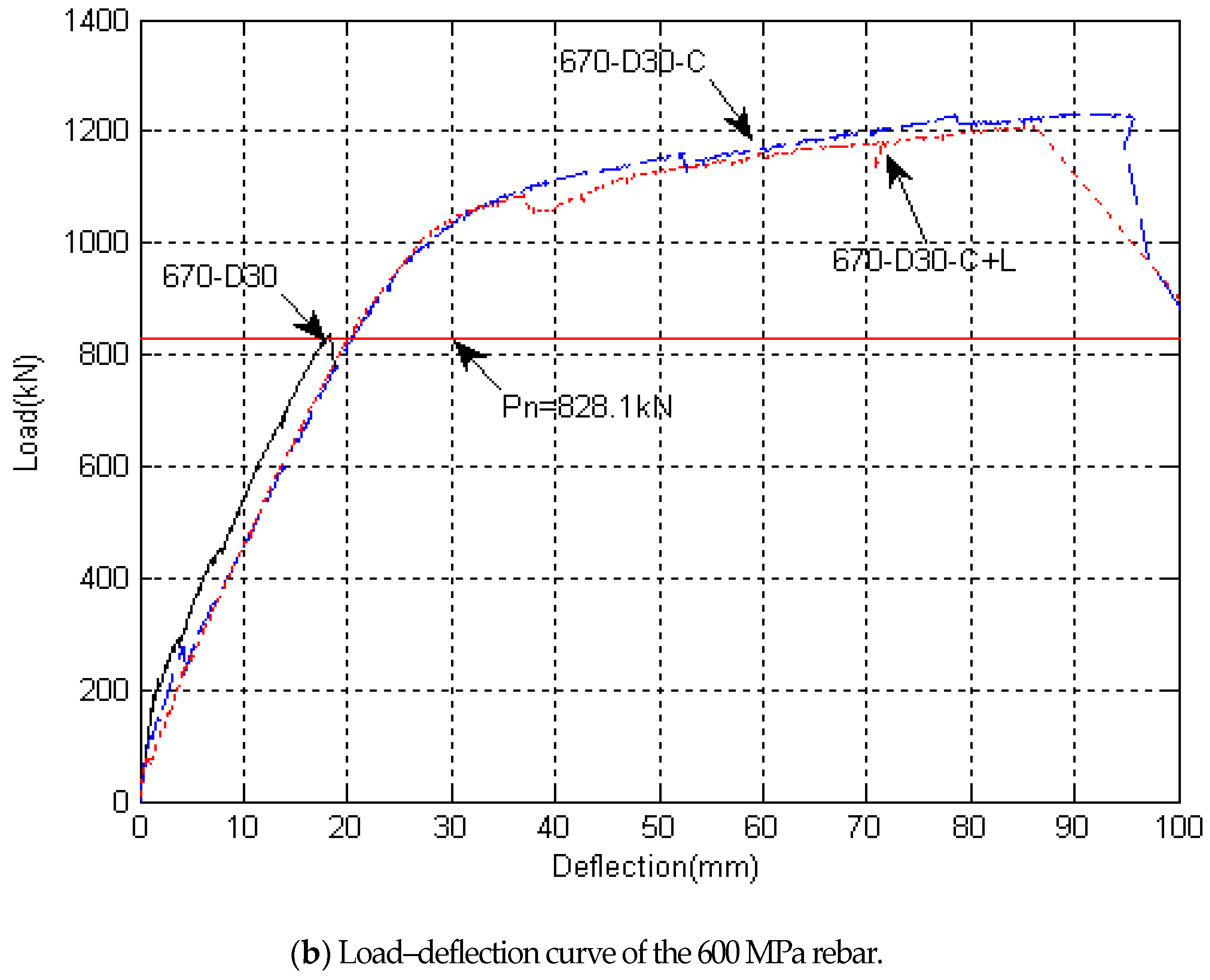
| Test Model Name | Concrete Grade (MPa) | Lap Splice Rebar (MPa) | Cover and Bar Spacing | Stirrup at Splice | c (mm) | 1.3 (mm) | Load (kN) | |||
|---|---|---|---|---|---|---|---|---|---|---|
| 600D32 | 70 | 600 | 70 | 70 | 86 | No | 86 | 2.69 | 1074 | 822.9 |
| 600D32C | coupler | |||||||||
| 600D32CL | coupler + lock nut | |||||||||
| 670D30 | 670 | 70 | 70 | 86 | No | 86 | 2.69 | 1125 | 828.1 | |
| 670D30C | coupler | |||||||||
| 670D30CL | coupler + lock nut | |||||||||
| W/B (%) | S/a (%) | Unit Weight (kgf/m3) | |||||||
|---|---|---|---|---|---|---|---|---|---|
| W | B | CE | FA | SF | S1 | G | AD3 | ||
| 23.8 | 47.5 | 114 | 650 | 481 | 130 | 39 | 735 | 835 | 9.75 |
| Age | 3 Days | 7 Days | 14 Days | 28 Days | 56 Days |
|---|---|---|---|---|---|
| Average (MPa) | 52.7 | 62.2 | 76.0 | 83.5 | 91.8 |
| Threaded Bar | Maximum Diameter | Pitch (c, mm) | Area | Weight (kg/m) | Coupler | Size d × L (mm) | Weight (kg) | Lock Nut | Size d × L (mm) | Weight (kg) |
|---|---|---|---|---|---|---|---|---|---|---|
| SAS600 D32 | 36 | 16 | 804 | 6.31 | Th-3003-32 | 55 × 150 | 1.32 | T-2002-32 | 55 × 60 | 0.86 |
| SAS670 D30 | 34 | 11 | 707 | 5.55 | Tr3003-30 | 55 × 150 | 1.83 | TR-2003-30 | 50 × 60 | 0.67 |
| Threaded Bar | Yield Strength (MPa) | Tensile Strength (MPa) | Bearing Displacement | ||
|---|---|---|---|---|---|
| Initial State (mm) | Work State (mm) | Yield State (mm) | |||
| 600D32 | 651 | 761 | - | - | - |
| 600D32 Coupler | 640 | 759 | 0.1 | 0.37 | 0.58 |
| 600D32 Coupler + Lock nut | 650 | 761 | 0.1 | 0.25 | 0.43 |
| 670D30 | 743 | 874 | - | - | - |
| 670D30 Coupler | 725 | 874 | 0.14 | 0.41 | 1.07 |
| 670D30 Coupler + Lock nut | 724 | 871 | 0.01 | 0.15 | 1.05 |
| Test Model | Loads (kN) | Yielding Load | Maximum Load | Failure Mode | ||||
|---|---|---|---|---|---|---|---|---|
(kN) | Deflection (mm) | (kN) | Deflection (mm) | |||||
| 600D32 | 822.9 | - | - | 902.6 | 19.8 | - | 1.09 | splitting |
| 600D32C | 973.7 | 25.3 | 1096.4 | 69.4 | 1.18 | 1.33 | yielding | |
| 600D32CL | 987.1 | 26.5 | 1155.4 | 96.0 | 1.20 | 1.40 | yielding | |
| 670D30 | 828.1 | - | - | 830.8 | 18.3 | - | 1.00 | splitting |
| 670D30C | 942.4 | 23.1 | 1206.3 | 94.8 | 1.14 | 1.45 | yielding | |
| 670D30CL | 934.4 | 22.5 | 1228.5 | 86.5 | 1.13 | 1.48 | yielding | |
Publisher’s Note: MDPI stays neutral with regard to jurisdictional claims in published maps and institutional affiliations. |
© 2021 by the authors. Licensee MDPI, Basel, Switzerland. This article is an open access article distributed under the terms and conditions of the Creative Commons Attribution (CC BY) license (http://creativecommons.org/licenses/by/4.0/).
Share and Cite
Cho, S.; Lim, M.; Lee, C. Study on the Bending and Joint Performances of Reinforced Concrete Beams Using High-Strength Rebars. Sustainability 2021, 13, 3482. https://doi.org/10.3390/su13063482
Cho S, Lim M, Lee C. Study on the Bending and Joint Performances of Reinforced Concrete Beams Using High-Strength Rebars. Sustainability. 2021; 13(6):3482. https://doi.org/10.3390/su13063482
Chicago/Turabian StyleCho, Seoungho, Myungkwan Lim, and Changhee Lee. 2021. "Study on the Bending and Joint Performances of Reinforced Concrete Beams Using High-Strength Rebars" Sustainability 13, no. 6: 3482. https://doi.org/10.3390/su13063482






